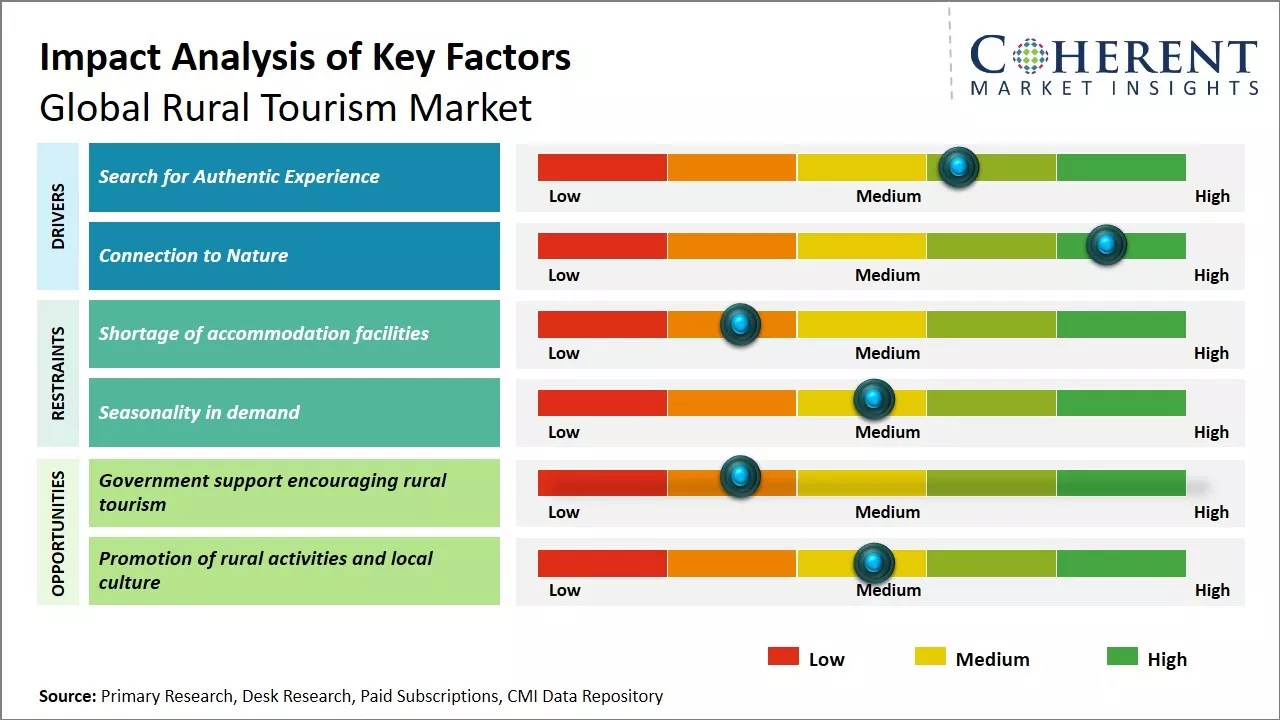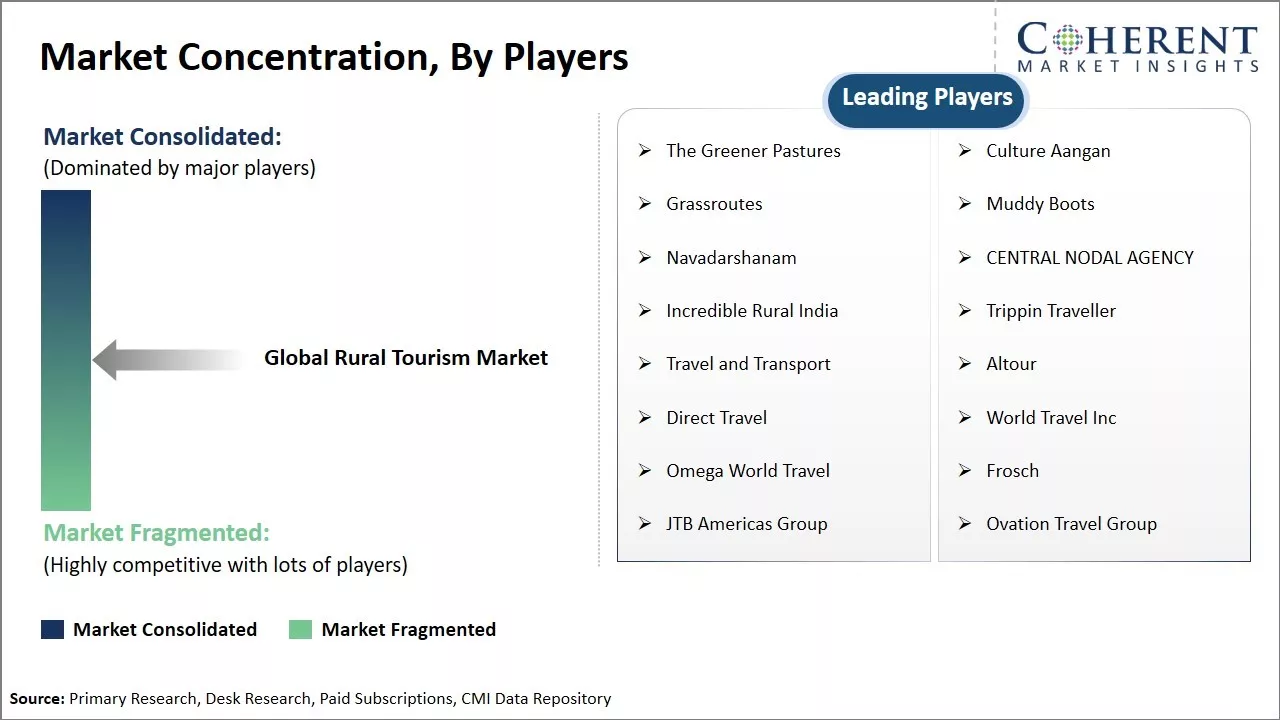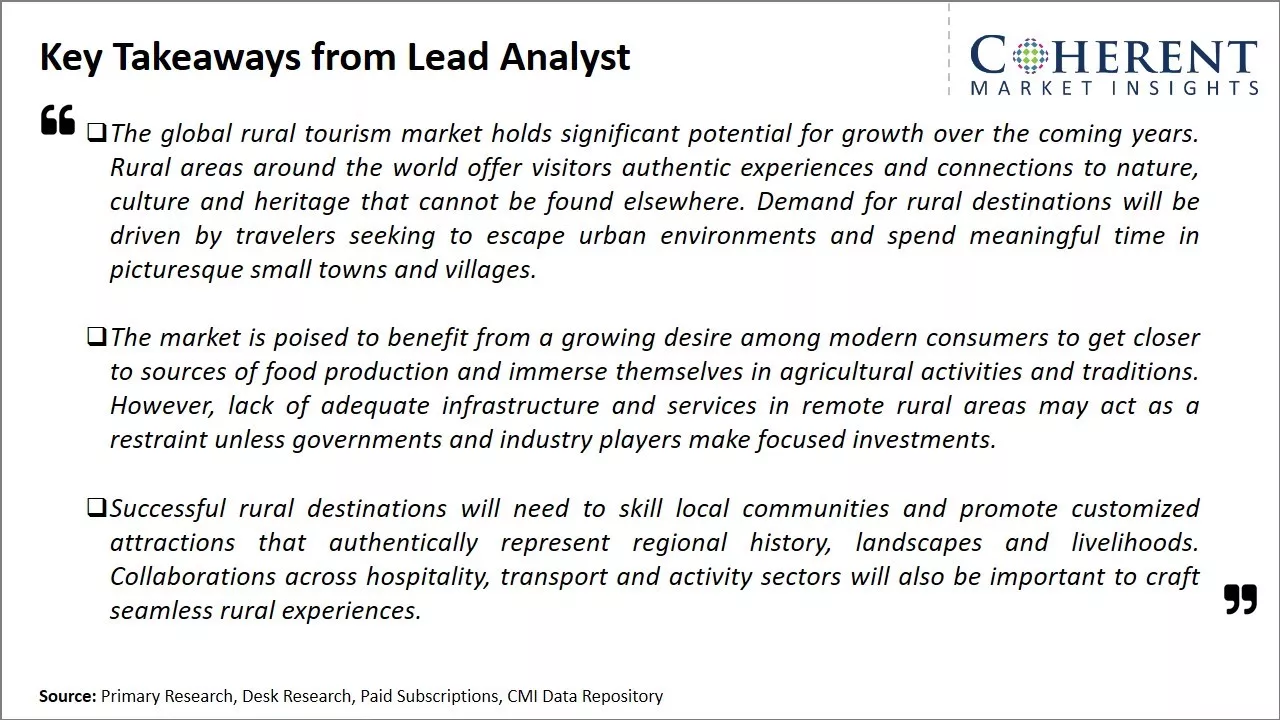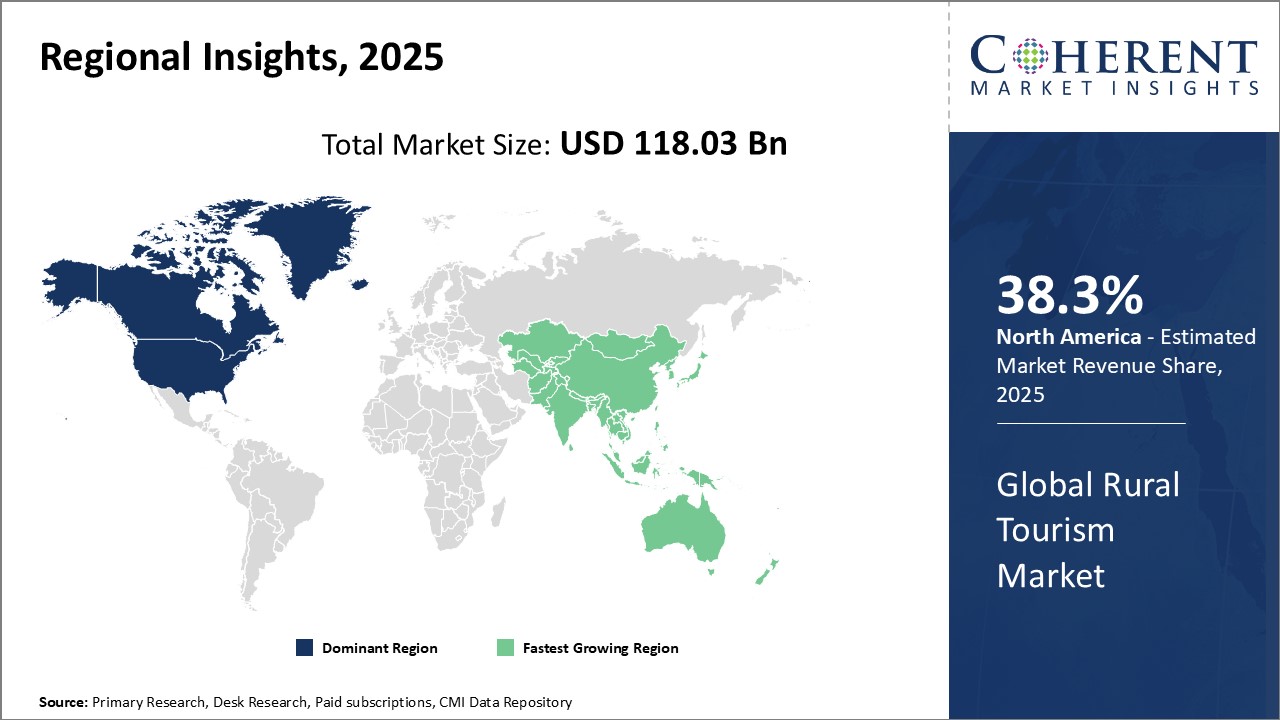Global rural tourism market is estimated to be valued at USD 118.03 Bn in 2025 and is expected to reach USD 193.41 Bn by 2032, exhibiting a compound annual growth rate (CAGR) of 7.3% from 2025 to 2032.

Discover market dynamics shaping the industry: Request sample copy
Rural tourism is increasingly becoming popular among millennials and generation Z as these people want to disconnect from their busy urban lives and get a sense of community. Since the COVID-19 pandemic, there has been a greater preference for open spaces and staying in villas or homes away from crowded cities and international travel. Rural destinations offer tourists an opportunities to engage in activities like hiking, cycling, ranch stays, farm tours and explore local culture and cuisine. Many countries are also promoting rural areas as tourist destinations and developing infrastructure to boost incomes and employment opportunities for local communities.
Search for Authentic Experience
The search for authentic and experiential travel is expected to drive the growth of the global rural tourism market. Tourists are increasingly seeking out trips that allow them to deeply engage with local cultures and communities in natural, less commercial settings. Rural areas offer visitors exactly these kinds of enriching experiences through activities like farmstays, cultural activities, outdoor adventures, and gastronomic explorations rooted in regional traditions. By opting for rural tourism, travelers can gain a true sense of local life and forge meaningful connections with residents in a way that is rarely possible through conventional mass tourism. Being in contact with farmers, artisans, and families residing in villages provides authentic insights into daily routines, cultural practices, cuisine, crafts, and the natural landscape. This makes rural destinations highly attractive for modern tourists who wish to avoid staged experiences and instead participate in genuine local experiences. The desire to escape over tourism in crowded urban areas and find unspoiled natural beauty has also boosted interest in rural getaways. According to the data from United Nations World Tourism Organization (UNWTO), international tourist arrivals to rural areas had increased by over 28% between 2016 to 2019, significantly outpacing the growth of global tourism overall during this period. Countries worldwide have recognized this strong demand and are proactively developing their rural tourism circuits and infrastructure. For example, the Indian government's PRASHAD (National Mission on Pilgrimage Rejuvenation and Spiritual, Heritage Augmentation Drive) scheme aims to boost rural tourism by developing cultural and heritage sites in villages across different states. European Union is investing in rural development projects that emphasize cultural preservation and visitor activities centered on local traditions, art, and nature. Such initiatives can drive the growth of global rural tourism industry by making more rural destinations accessible to travelers seeking authentic experiences off the beaten path.

Get actionable strategies to beat competition: Request sample copy
Connection to NatureAnother major factor driving the market growth is the desire among both domestic and international travelers to escape urban confinements and reconnect with natural surroundings. As modern lifestyles become increasingly digitized and fast-paced, many people feel the need to take a step back from technology and immerse themselves in natural environments for leisure and relaxation. Rural areas provide the perfect settings for such experiences through activities like hiking, cycling, wildlife viewing, fishing, hiking, camping and other outdoor pastimes. Being able to unwind in fresh air and wide-open spaces away from traffic, pollution and noise has strong health and wellness benefits. This attracts a whole new category of “nature tourists" who structure their vacations around outdoor pursuits and taking in breathtaking rural scenery. Rural destinations hold fascinating natural attractions like mountains, valleys, coastlines, forests, lakes and rivers that add tremendous value for travelers. Engaging with the flora, fauna and landscapes unique to a rural region enhances cultural understanding as well.

To learn more about this report, Request sample copy
Challenge: Shortage of accommodation facilitiesShortage of accommodation facilities can hamper the growth of global rural tourism market. Rural tourism has great potential to provide livelihood opportunities and economic development in rural areas. However, lack of suitable accommodation options discourages tourists from exploring rural destinations. Most villages and small towns in developing nations still lack basic accommodation facilities like hotels, homestays, Guest houses, and others that meet necessary comfort and hygiene standards required by modern tourists. While many villages have scenic natural attractions and cultural heritage sites, absence of a place to stay overnight deters travelers. This is a significant roadblock in attracting tourists who usually look for packaged rural experience including guidance, food and comfortable accommodation. According to the UNWTO World Tourism Barometer Report for 2021, accommodation was listed as top missing amenity by 40% of tourists surveyed across Asia Pacific nations which are major sourced of rural tourist inflow. Even where some accommodation exists, the capacity is highly limited and unable to cater to growing tourist numbers. Most rural homestays or small hotels are family run with very few rooms. During peak seasons, this results in high occupancy rates and visitors often getting turned away due to lack of vacant rooms. According to the World Bank Report on rural livelihoods in 2022, less than 20% villages in Africa have tourist lodging facilities with more than 10 beds. This highlights massive scarcity of appropriate accommodation infrastructure hampering realization of rural tourism’s potential.
Opportunity: Government support encouraging rural tourism
Government support can provide a great opportunity to boost rural tourism in global markets. Rural areas often have beautiful natural scenery, historical sites and a slower pace of life that many tourists find appealing, however, rural communities may lack infrastructure and amenities needed to attract large numbers of visitors. With strategic governmental policies and investments, rural tourism can be developed in a sustainable manner. Government schemes to build or improve rural roads, trails and transport links can make destinations more accessible to domestic and international tourists. This will open up economically important but previously remote regions to tourism. Infrastructure projects could also focus on improving broadband connectivity in villages. Reliable high-speed internet access will allow rural businesses to better market attractions and accept online reservations. It will also encourage digital nomads and remote workers to visit and spend longer durations in rural idyllic settings. Promoting rural destinations and offering training and skill development to local communities can boost rural economies through tourism. For instance, according to the United Nations World Tourism Organization, in 2021, over 75% of villages in Vietnam received official recognition and support for developing community-based tourism. This has led to the creation of homestays, handicraft workshops, cultural experiences and agri-tourism activities, thus, generating new sources of income in rural areas. Targeted funding and training related to hospitality, languages, marketing and adventure activities can unlock local entrepreneurship. It can also help locals benefit more directly from the growing rural tourism trend rather than tourism benefits being captured by large urban hotel and transport companies.

Discover high revenue pocket segments and roadmap to it: Request sample copy
Insights, By Tour Type: Agro-tourism segment contributes the highest share of the market, owing to growing interest in knowing how food is produced and connectedness with natureAmong tour type, agro-tourism segment is estimated to hold 32.1% of market share in 2025. Agro-tourism allows visitors to experience agricultural processes and rural lifestyles first-hand. Farm visits offer insights into cultivation practices and seasonal operations. Hands-on activities like harvesting crops, milking cows, collecting eggs appeal greatly to those wanting to spend time in open spaces immersed in nature. The opportunity to learn from and help farmers fosters respect for food producers and the environment. Rural retreats give a break from urban bustle while reconnecting people to the cycles of planting and nature. Picturesque farmlands and encounters with farm animals are a soothing experience for those stressed in cities. The fresh air and scenic rural landscapes uplift moods. Some travelers use agro-vacations to educate children on responsible land management and sustainability lessons rarely found in textbooks. Farm-stays also provide locally sourced and organic meals, thus, highlighting regional cuisines. Visitors satisfy curiosity to sample authentic regional dishes prepared from farm-grown ingredients.
Insights, By Traveler Type: Group travelers segment contributes the highest share of the market due to benefits of shared experiences with bonding over activities and memories created together
Among traveler type, group travelers segment is estimated to hold 68.1% of market share in 2025. Travelling with companions multiplies the fun through experiences enjoyed as a team rather than individually. Rural retreats offer a variety of group activities to bring people together such as farm work, cooking classes, craft workshops, amateur sports, campfires and folk performances. Engaging in tasks side-by-side strengthen bonds within friend and family circles. Memorable group trips create cherished memories shared for years with traveling partners. Joint participation in unique rural programs, pictures together amidst picturesque farmlands, and reminiscing over meals and accommodation provide quality time for not just individuals but also the entire ensemble. This fosters stronger interpersonal relationships and social well-being.
Insights, By Accommodation: Rural homestays segment contributes the highest share of the market owing to the appeal of truly immersive cultural experiences
Among accommodation, rural homestays segment is estimated to hold 36.1% market share in 2025. Staying with local families offers unprecedented access into their daily routines and regional lifestyles. Homestays provide a lived-in experience of rural life rather than just a glimpse. Interacting with warm local hosts over generous home-cooked meals nurtures close-knit bonds rarely found elsewhere. Such heartfelt hospitality strengthens cross-cultural connections. Simple rustic rooms with personalized services feel more authentic than commoditized hotel stays. Learning regional dialects, assisting on farms, enjoying local delicacies alongside families are memories that last far beyond trips. The accommodation itself becomes a lesson in sustainable rural living with minimal ecological footprint. Most importantly, homestays support marginal rural economies and forestall village desertion. Earnings directly empower farming families with livelihood security and pride in their cultural heritage. Tradition bearers gain a platform to pass on arts, crafts and community values to outsiders. Together villagers and visitors reinforce preservation of priceless localized culture and nature. Rural homestays offer the most immersive cultural exchange in breathtaking natural settings.

Need a Different Region or Segment? Customize now
North America has established itself as the dominant region in the global rural tourism market with estimated 38.3% market share in 2025. The U.S., in particular, has a strong rural tourism industry due to many national parks, nature reserves and scenic areas that attract tourists worldwide. States like California, Montana and Colorado have thriving agriculture and farming industries that offer tours and activities centered on rural lifestyle. This has enabled them to leverage rural attractions for tourism purposes. The agri-tourism market has found widespread acceptance among both international and domestic travelers. Furthermore, the region has a highly developed infrastructure that facilitates easy access to rural destinations.
Asia Pacific region has emerged as the fastest growing market for rural tourism owing to rapid development of tourism industry across many countries. China has heavily promoted rural experiences to offset an aging population in remote villages. The government supports various rural tourism projects that has led to spurt in small businesses and generation of local employment. India has also witnessed increase in demand for activities related to rural heritage and culture. States like Rajasthan and Kerala have revolutionized their rural landscape and folklore into compelling tourist propositions. The popularity of agricultural tours, farm stays, cultural festivals, and others is on the rise.
Global Rural Tourism Market Report Coverage
| Report Coverage | Details | ||
|---|---|---|---|
| Base Year: | 2024 | Market Size in 2025: | USD 118.03 Bn |
| Historical Data for: | 2020 To 2024 | Forecast Period: | 2025 To 2032 |
| Forecast Period 2025 to 2032 CAGR: | 7.3% | 2032 Value Projection: | USD 193.41 Bn |
| Geographies covered: |
|
||
| Segments covered: |
|
||
| Companies covered: |
The Greener Pastures, Culture Aangan, Grassroutes, Muddy Boots, Navadarshanam, CENTRAL NODAL AGENCY, Incredible Rural India, Trippin Traveller, Travel and Transport, Altour, Direct Travel, World Travel Inc, Omega World Travel, Frosch, JTB Americas Group, Ovation Travel Group |
||
| Growth Drivers: |
|
||
| Restraints & Challenges: |
|
||
Uncover macros and micros vetted on 75+ parameters: Get instant access to report
*Definition: Global Rural Tourism Market consists of rural tourism activities and services catered towards tourists in rural areas around the world. It involves visits to small villages and farms, experiences of outdoor activities like hiking, fishing, hunting, farm tours, cooking classes using local ingredients, and others aimed at experiencing rural lifestyles. The market provides opportunities for rural communities to generate additional incomes and promote conservation of cultural heritage, traditions and biodiversity. It helps in rural economic development and growth of local businesses.
Share
Share
About Author
Yash Doshi is a Senior Management Consultant. He has 12+ years of experience in conducting research and handling consulting projects across verticals in APAC, EMEA, and the Americas.
He brings strong acumen in helping chemical companies navigate complex challenges and identify growth opportunities. He has deep expertise across the chemicals value chain, including commodity, specialty and fine chemicals, plastics and polymers, and petrochemicals. Yash is a sought-after speaker at industry conferences and contributes to various publications on topics related commodity, specialty and fine chemicals, plastics and polymers, and petrochemicals.
Missing comfort of reading report in your local language? Find your preferred language :
Transform your Strategy with Exclusive Trending Reports :
Frequently Asked Questions
Joining thousands of companies around the world committed to making the Excellent Business Solutions.
View All Our Clients
US Reciprocal Tax Impact Analysis On Global Rural Tourism Market
Stay updated on tariff changes with expert insights and timely information